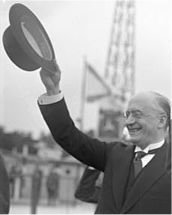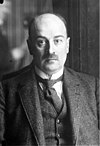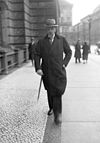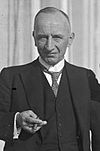Cabinet Brüning I
The Brüning I cabinet was in office from March 31, 1930 to October 9, 1931 . This government was the first presidential cabinet of the Weimar Republic , led by the center politician Heinrich Brüning . The Brüning I cabinet ruled during the fourth period of the German Reichstag .
prehistory
After the Müller II cabinet had ostensibly collapsed due to a slight increase in unemployment insurance contributions (more precisely: Müller II cabinet, break of the coalition ), Reich President Hindenburg appointed central politician Heinrich Brüning as Chancellor in March 1930 as the successor to Social Democrat Hermann Müller .
Strategically wanted, but constitutionally problematic presidential government
Far into the middle class, it was thought that coalition governments were too weak to cope with the problems. At least that was what the Müller II cabinet had shown. Hindenburg appointed Brüning Chancellor "with the note that his cabinet was to be put together without being bound by a coalition ."
However, according to Article 54 of the Constitution, the Reich Chancellor required the confidence of the Reichstag in order to exercise his office and had to resign if the Reichstag expressly withdrew his confidence in him. The appointment of the Chancellor by the Reich President in Article 53 was only a formality.
Article 48, paragraph 1, of the Constitution, however, spoke of the right of the President to use armed force to encourage a country to fulfill its statutory duties. Paragraph 2 of the article spoke of measures to restore public security and order; Paragraph 3 of the article states that these measures are to be overridden at the request of the Reichstag.
Briining now thought of “governing with parliament if it was willing to cooperate […]; or to govern without parliament on the basis of the interpretable article ”: by (emergency) presidential decrees, which parliament could override if it so wished, with the prospect of new elections. This should leave the seemingly inaccessible path of a parliamentary government and move on on the path of a presidential government.
Government action
Brüning was a Christian trade unionist, but finances had to be restructured, as the step towards currency reform in 1923 had taught: painful reductions in social benefits, higher taxes, and curbing of imports. "Wages would follow, then prices too." ( Austerity policy )
Briining brought a first bundle of appropriate measures through the Reichstag with the help of the conservatives and the SPD. But then the Reichstag rejected the Reich budget for 1930 (covering measures) presented by Brüning. Now the apparently constitutionally possible exchange of blows followed:
- At Brüning's request, Reich President Hindenburg converted the draft law into an emergency ordinance on "Securing the economy and finances" on July 16 .
- Thereupon, at the request of the SPD, with 256 votes from the SPD, KPD, NSDAP and DNVP, the Reichstag made use of its right under Article 48 of the Weimar Constitution to reject an emergency ordinance.
- Because the Reichstag constellation also caused the minority government of Brüning to fail, Chancellor Brüning then asked President Hindenburg to dissolve the Reichstag and call new elections.
In order to prevent further dissolution of parliament, the SPD decided to tolerate the Brüning government in the future after Brüning had held intensive talks with the SPD with the suggestion that the next new elections would be even more devastating for democracy in Germany. (The NSDAP had just received 18.3% of the vote; in the next election in July 1932 it was to achieve 37.3%.) The Social Democrats had to pass emergency ordinances in parliament that were much tougher for the workers “than those for their sake they broke up the last parliamentary coalition in the spring. ”Communists or National Socialists always applied for the repeal of an emergency ordinance. Each time this was rejected with the votes of the governing parties and the SPD.
End of the Brüning I cabinet
After the attempt to establish a German-Austrian customs union had failed on September 5, 1931 and Foreign Minister Curtius had resigned because of this, Brüning was, besides Schleicher and Hindenburg, also in favor of a more right-wing policy. After Briining Hindenburg had promised to appoint significantly more conservative ministers who were not so politically bound and neither Catholic nor left, Hindenburg accepted the resignation of the Briining government and at the same time commissioned Briining to form a new government.
Cabinet List

| Cabinet Brüning I March 31, 1930 to October 9, 1931 |
||||
|---|---|---|---|---|
| Chancellor | Heinrich Brüning | center | ||
| Vice Chancellor | Hermann Dietrich | DDP | ||
| Ministry of Foreign Affairs | Julius Curtius | DVP | ||
| Interior | Joseph Wirth | center | ||
| Finances |
Paul Moldenhauer until June 28, 1930 |
DVP | ||
| Hermann Dietrich | DDP | |||
| economy | Hermann Dietrich until June 28, 1930 |
DDP | ||
| State Secretary Ernst Trendelenburg charged with running the business |
DDP | |||
| job | Adam Stegerwald | center | ||
| Judiciary |
Johann Viktor Bredt until December 5, 1930 |
WP | ||
| State Secretary Curt Joël entrusted with the conduct of business |
independent | |||
| Reichswehr | Wilhelm Groener | independent | ||
| post Office | Georg Schätzel | BVP | ||
| traffic | Theodor von Guérard | center | ||
| Food and Agriculture |
Martin Schiele |
DNVP until July 22, 1930 |
||
| CNBL | ||||
| Occupied Territories |
Gottfried Treviranus until September 30, 1930 |
CIP | ||
| Without business area | Gottfried Treviranus from October 1, 1930 |
CIP | ||
literature
- Herbert Hömig: Brüning. Chancellor in the crisis of the republic. Schöningh, Paderborn 2000, ISBN 3-506-73949-2 .
- Gerhard Schulz : From Brüning to Hitler. The change in the political system in Germany 1930–1933 (= Between Democracy and Dictatorship. Constitutional Policy and Imperial Reform in the Weimar Republic, Volume 3); Walter de Gruyter, Berlin / New York 1992, ISBN 3-11-013525-6 .
- Peer Oliver Volkmann: Heinrich Brüning (1885–1970). Nationalist without a home . Droste, Düsseldorf 2007.
Web links
- Negotiations of the Reichstag - Volume 443 - Changes in the Reich Government
- Negotiations of the Reichstag - Volume 453 - Changes in the Reich Government
Individual evidence
- ^ A b Golo Mann : German history of the 19th and 20th centuries . Fischer Taschenbuch 2001, p. 755
- ^ Golo Mann : German history of the 19th and 20th centuries . Fischer Taschenbuch 2001, p. 756
- ^ A b Golo Mann : German history of the 19th and 20th centuries . Fischer Taschenbuch 2001, p. 757
- ^ Golo Mann : German history of the 19th and 20th centuries . Fischer Taschenbuch, 2001, p. 766












